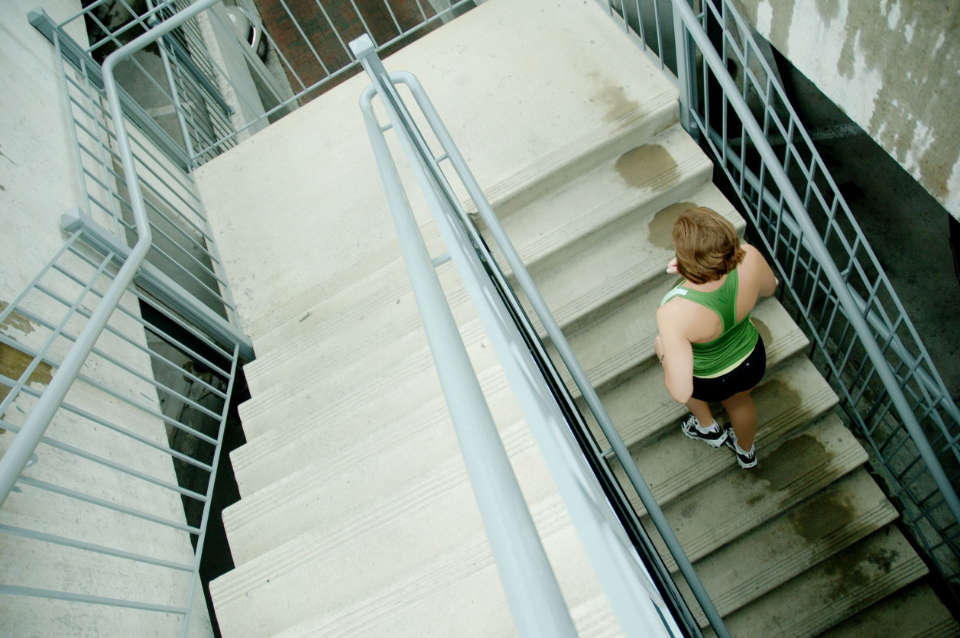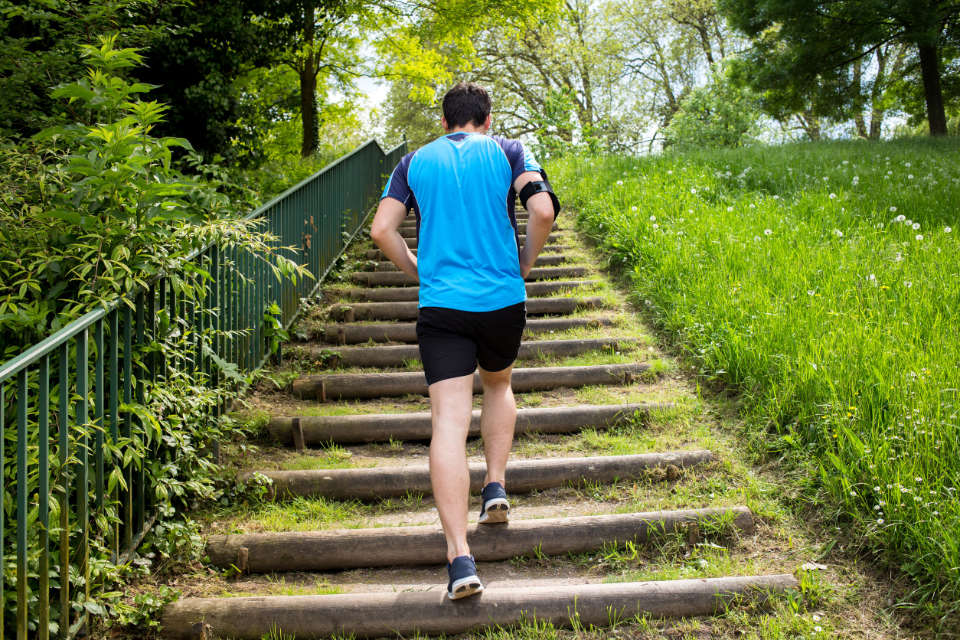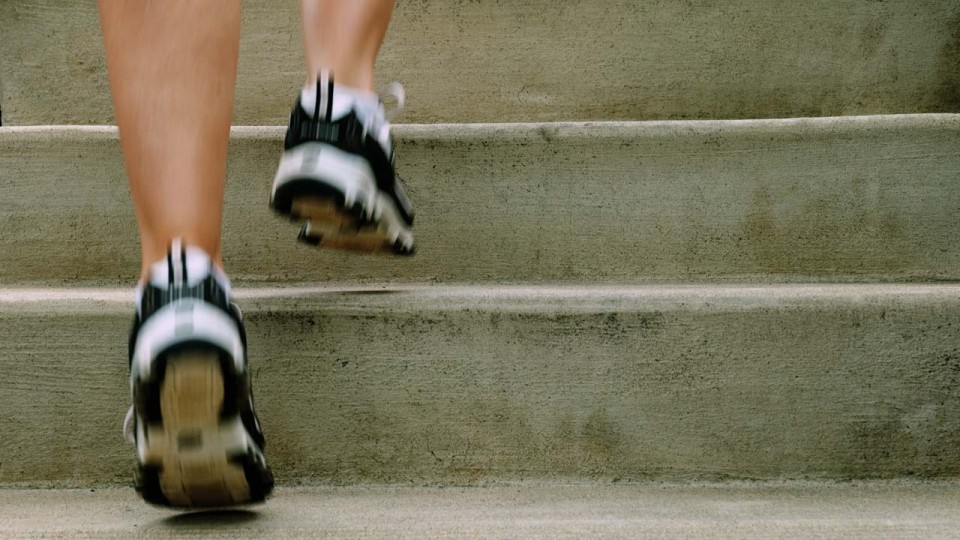Both running and stair climbing are great exercise routines. Running and stair climbing have aerobic benefits and tone muscles in the legs and buttocks. However, stair climbing affords many more benefits than running, jogging or walking.
Stair climbing builds muscles in the lower body and burns calories.
In this Article
Benefits of Stair Climbing
Many people choose stair climbing regimens for regular exercise. Benefits of stair climbing that are not experienced with running or walking include:
Vertical Movement in Stair Climbing
When walking and running, your body moves in a horizontal pattern. With running, your body does experience slight vertical movement.
However, with stair climbing, your muscles are forced to resist gravity and move in a vertical pattern. When you move your body vertically, you place high demands on the lower body.
Your leg muscles must repeatedly lift your body against the pull of gravity. In addition, your muscles must stabilise and balance, which puts even more demand on the muscles in the lower body.

Stair Climbing is Readily Available
Stairs are generally readily available. Those who run for exercise generally prefer to have a span of distance over which they may travel. Stairs, on the other hand, are readily available in apartments, office buildings, on streets and in public areas.
Stairs are “compact.” Those who prefer stair climbing to running simply need an ordinary staircase for their workout. In fact, all buildings that have elevators also have stairs. Those who prefer to stair climb for exercise may opt to take the stairs instead of the elevator when faced with this choice.
In addition, stair climbing requires no special clothing or equipment. You may want to wear comfortable workout clothes and shoes, but even if you are not dressed for a workout, you can still reap the aerobic and fat-burning benefits of stair climbing.
Stair Climbing Has Faster Benefits
When you stair climb, you burn twice the fat in half the time than if you run and three times more than walking.
An intense stair-climbing exercise session will produce more aerobic benefits in a shorter amount of time than running or walking. One hour of stair climbing will burn approximately 1,000 calories.
You burn about 0.17 calories for every step you climb and every stair descended burns about 0.05 calories on average. If you are heavier, the more calories you’ll burn and walking up stairs in high heels is a better calorie burner, but it’s not recommended for your posture and wellbeing overall.
No Weather Considerations For Stair Climbing
Those who walk or run for exercise rarely do so in harsh weather or rain. On the other hand, weather need not become an issue for stair climbers.
Indoor staircases are plentiful so weather is not as much of a consideration for those who choose to stair-climb for exercise.

Stair Climbing Has Less Impact
Stair climbing exposes the legs, ankles and knees to less pressure than running on concrete. Running places a considerable amount of pressure on the feet, as well.
It offers the benefit of less impact to the body while reaping more aerobic and muscle-building benefits.
Intensity Matters For Stair Climbing
Both running and walking burn calories and have aerobic benefits. However, those benefits may greatly increased with stair climbing. The calorie-burning and aerobic benefit of stair climbing is determined by how vigorously the activity is pursued.
If you casually walk up the stairs, the calorie-burning and aerobic benefits are only slightly higher than running or walking, but if you expend some effort and energy, quickly moving up the stairs, the benefit is greatly enhanced.
Overall benefits of adopting stair climbing as your exercise of preference include:
- Build and tone and muscle
- No need of any special equipment
- May be incorporated at any point throughout the day
- Burns fat and calories
- Increases heart rate
- Builds lower body muscle mass
- Reduces cholesterol levels
- Increases stamina and energy
How Many Stairs Should I Climb For A Good Workout?
To get a good workout, you can try climbing stairs with 10 to 12 steps, one step at at time. A flight up and down will burn around 2 to 5 calories.
A 54kg person burns about 235 calories when climbing stairs for 30 minutes or you can climb up and down a 10-storey building for 5 times to burn around 500 calories.
There are many factors that can influence the calories-burned-climbing-stairs question, such as the person’s current weight, the rise of the steps and the time of the climbing workout.
Is Climbing Two Steps at a Time Better?
Climbing two steps at a time will give your leg muscles and buttocks a more strenuous workout and burn more calories per minute.
However, the longer stride can be risky if you have poor balance, knee problems or short legs which may increase the chance of injuries. Mix your workout by changing from single-step to double-step climbing for a better balance.
Disadvantages of Climbing Stairs
Although stairs climbing is a great cardio exercise, it may not be suitable for everyone. So you should take note of these disadvantages of stairs climbing:
- Climbing stairs effectively works your leg muscles, but it doesn’t target other muscle groups in your body.
- For people with problems in the bones or soft tissues of their knees, climbing stairs might cause further injury.
- If you are overweight or have knee problems, running and climbing stairs must be done in moderation.
How to Convert Steps to Miles
Climbing a flight of 10 steps of stair is equivalent to taking 38 steps on level ground, according to a professor in the department of kinesiology, recreation and sport studies at the University of Tennessee.
With 2,000 steps to a mile, you’d need to climb around 50 flights to equal a single mile walked according to the expert. Another suggests a number closer to 350 flights to a mile.
How to Start Stair Climbing For Exercise
Experts recommend that when you begin stair climbing for exercise, you should start slow. Start with a 10 minute session three times per week of stair climbing and slowly build up to more time as your endurance increases.
When you first begin climbing stair for exercise, pay attention to any pain that you may experience in the knees, back, hips or ankles. Over time, build up to 30 minute session of stair climbing to reap the most benefits from climbing up the stairs.

Start your stair climbing routine by first warming up for five to ten minutes. Though walking slowly up and down the staircase will provide the necessary warm up, you should simply walk or do a few jumping jacks to prepare.
After all, you will be faced with overcoming the psychological barriers you face with the staircase. Performing a different activity for your warm-up will help you mentally prepare for your stair-climbing exercise session.
Those who run for exercise know the value of an intense run, as do those who are attempting to enhance their fitness through cardio activities. There are several reasons why a runner would incorporate stair climbing and stair running into their exercise routine. Stair climbing is a great way to cross-train if you are a runner.
A major purpose in cross training is to increase aerobic activity by using muscle groups that are not utilised when running. Stair climbing targets the gluteal muscles and quadriceps. By strengthening these muscles, you will increase power and strength for running.
Even though no special equipment is required for stair climbing, several stair climbing exercise machines are available that are convenient and compact.
If you prefer another form of exercise, such as bicycling or running, stair climbing is a great way to cross-train and place demands on different leg muscle groups.
Stair climbing is quickly growing in popularity as a convenient and fast way to stay fit.
Stair Climber vs Treadmill
If you don’t like to use the stairs for training, you can choose to use the stair climber or treadmill.
A stair climber is a cardio machine consisting of either two foot pedals or a set or revolving stairs. A stair climber is a low-impact machine, which is ideal for people with leg injuries and joint issues.
An incline on a treadmill can stimulate hills and terrain changes that come with outdoor walking or running. Treadmills can increase in inclination from 0 to 35 percent.
The treadmill is higher impact than the stair climber, especially when you increase the speed.
If you don’t have any leg injuries and joint issues, the treadmill incline walking would be a better choice for you. Otherwise, the stair climber may be more suitable for you.
Nonetheless, climbing the stairs is still the most effective in terms of improving heart and lung health than the stair climber.
Do you know that stair climbing is eligible as a race completion activity for Spacebib virtual races and online marathons? You can mix your run and climbing stair to clock your required distance to complete the race.
Who Should Avoid Stair Climbing: Alternatives and Medical Considerations
Certain groups should exercise caution or seek alternative activities to climbing stairs due to specific health concerns. While this exercise form is beneficial for many, it can be detrimental for others, according to medical and scientific findings:
1. Individuals with Joint Issues
People suffering from arthritis or other joint-related problems, especially in the knees, hips, or ankles, should generally avoid activities that put excessive stress on these areas. The repetitive motion and impact of ascending and descending stairs can exacerbate joint pain and inflammation.
2. Those with Heart Conditions
Patients with cardiovascular issues, including heart disease, should consult their doctor before engaging in climbing stair. While moderate physical activity is often recommended for heart health, the intensity of climbing stairs might be too strenuous for some, potentially leading to increased heart strain.
3. People with Balance or Vertigo Issues
Climbing stair requires good balance. Those with conditions affecting their balance, such as vertigo, are at a higher risk of falls and injuries when using stairs.
4. Pregnant Women
Pregnant women, especially in their later stages, might find climbing stair challenging and risky due to changes in balance and center of gravity. The risk of falls and joint stress are concerns here.
5. Individuals Recovering from Surgery
Postoperative patients, particularly those recovering from surgeries related to the lower extremities or abdominal area, should avoid this activity until fully healed, as it can hinder the recovery process.
Alternatives to Stair Climbing
For those who should avoid stair climbing, there are safer alternatives that still provide cardiovascular and muscular benefits:
- Walking: Low-impact and can be adjusted in intensity.
- Swimming: Provides a full-body workout with minimal joint strain.
- Cycling: Great for cardiovascular health, with less impact on joints.
- Elliptical Training: Mimics stair climbing but with reduced impact.
- Yoga and Pilates: Improve flexibility and strength with low risk of injury.
The alternatives listed above can provide effective and safer options for maintaining physical fitness for those who need them.
Does climbing stair help running?
Yes. Stair running changes things up as you’ll not only use different muscles, but you’ll engage your brain. Running up stairs also taxes your body more than running up hills and can improve your VO2 max which allows you to run harder and longer.
Is stair climbing cardio?
Yes. Stair climbing is a great cardiovascular exercise that burns lots of calories, while developing both strength and power. It’s a great way to strengthen and tone your legs – from your calves to your butt usually without the impact commonly associated with jogging, running or sprinting.
Is running up stairs a good workout?
Running stairs is an effective high-intensity workout that builds speed, power, agility and cardiovascular fitness. Running stairs is efficient because it targets many major muscle groups and is an excellent workout which can burn 889 calories per hour running upstairs for a 64 kg person.
Can you run stairs everyday?
Running stairs is considered a hit intensity workout and it’s not recommended to do it continuously for more than an hour. You should break up your stair running workout in intervals to allow your heart rate and muscles time to recover.





